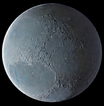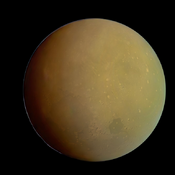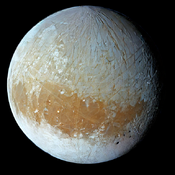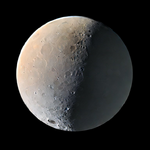Cyadon
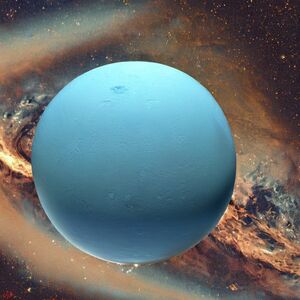 The image of the planet Cyadon in the artist's view | |||||||||||||
| Orbital characteristics | |||||||||||||
|---|---|---|---|---|---|---|---|---|---|---|---|---|---|
| Aphelion | 5.45705 AU (816.363 Gm) | ||||||||||||
| Perihelion | 4.95057 AU (740.595 Gm) | ||||||||||||
| 19.386 Gm (0.12959 AU) | |||||||||||||
| Eccentricity | 0.0489 | ||||||||||||
| |||||||||||||
Average orbital speed | 44.89 km/s | ||||||||||||
| 292.55° | |||||||||||||
| Inclination |
| ||||||||||||
| 51.6° | |||||||||||||
| Known satellites | 25 (satellites ofCyadon) | ||||||||||||
| Physical characteristics | |||||||||||||
Mean radius | 25,362±7 km | ||||||||||||
Equatorial radius | 25,559±4 km 4.007 Earths | ||||||||||||
Polar radius | 24,973±20 km 3.929 Earths | ||||||||||||
| Flattening | 0.0229±0.0008 | ||||||||||||
| Circumference | 159,354.1 km | ||||||||||||
| 8.1156×109 km2 15.91 Earths | |||||||||||||
| Volume | 6.833×1013 km3 63.086 Earths | ||||||||||||
| Mass | 1.039824×1026 kg 14.536 Kelera's GM=5,793,939±13 km3/s2 | ||||||||||||
Mean density | 1.27 g/cm3 | ||||||||||||
| 8.69 m/s2 0.886 g | |||||||||||||
| 0.23 | |||||||||||||
| 21.3 km/s | |||||||||||||
| −0.37573 d −9 h 01 m 03 s | |||||||||||||
Equatorial rotation velocity | 2.59 km/s 9,320 km/h | ||||||||||||
| 29.09° (to orbit) | |||||||||||||
North pole right ascension | 257.311° | ||||||||||||
North pole declination | −15.175° | ||||||||||||
| Albedo | 0.300 (Bond albedo) 0.488 (Geometric albedo) | ||||||||||||
| |||||||||||||
| 3.3″ to 4.1″ | |||||||||||||
| Atmosphere | |||||||||||||
| 27.7 km | |||||||||||||
| Composition by volume | Below 1.3 bar (130 kPa):
| ||||||||||||
Cyadon or Tau Lanus d is the third planet from the Star, taking about 30 days to complete an orbit and the largest in the Tau Lanus System. Cyadon is an ice giant, unlike gas giants, consisting mainly of hydrogen and helium, there is no metallic hydrogen in the depths of Cyadon, but there is a lot of ice in its high-temperature modifications. For this reason, experts have classified it in the category of "ice giants". The basis of the atmosphere of Cyadon is hydrogen and helium. It has the coldest atmosphere in the Tau Lanus system, with a minimum temperature of 49 kelvins (−224 °C; −371 °F). He it has a complex, layered cloud structure; water is thought to make up the lowest clouds and methane the uppermost layer. The planet's interior is mainly composed of ices and rock. Cyadon was found to have 25 natural satellites. The four main satellites are Cyadon 1, Cyadon 2, Cyadon 3 and Cyadon 4. Cyadon as an almost featureless planet in visible light, without the cloud bands or storms associated with the other giant planets. Wind speeds can reach 250 metres per second (900 km/h; 560 mph). The planet and its moons are located at the outer edge of the habitable zone.
Discovery and exploration
Within the framework of the program "KELERA: Knowledge Exploration and Long-term Expansion for Resource Acquisition", a team of scientists and researchers went on a mission to discover and explore the planet of the ice (gas) giant Cyadon. Their goal was to extract helium-3, a rare isotope that was necessary for the operation of thermonuclear installations.
The journey to the stadium was long and treacherous, as the planet was located in a remote corner of the galaxy, in the system of the red dwarf Tau Lanus. The team had to pass through the asteroid belt using advanced sensors and propulsion systems to avoid collisions and not get off course.
After a very long journey, the team finally arrived at the stadium - a frozen world shrouded in a thick layer of clouds and fog. The autonomous helium-3 mining station was located between the low orbit and the upper layers of the atmosphere, and the working colony is located on the second satellite of the Ice Giant - Cyadon 2.
Name
The name "Cyadon" could be derived from a combination of two words: "Cya" (meaning "icy" or "frosty") and "don" (meaning "lord" or "ruler"). This name could be fitting for a planet that is dominated by icy conditions and extreme weather patterns, with a harsh environment that only the strongest and most resilient lifeforms can survive.
satellites of Cyadon
The ice (gas) giant Cyadon was not only home to a wealth of resources, but it also had a fascinating system of moons orbiting around it. In total, there were 25 natural satellites that had been discovered and the four main satellites are Cyadon 1, Cyadon 2, Cyadon 3 and Cyadon 4.
Cyadon 1
Cyadon 1 is the closest and smallest of the four major satellites of Cyadon. The axis of rotation of Cyadon 1, like other large satellites of Cyadon, lies almost in the plane of the planet's orbit, and this leads to very peculiar seasonal cycles. Cyadon 1 was formed, most likely from an accretion disk (or nebula) that existed around Cyadon for some time after the formation of the planet
The surface of the satellite consists of water ice mixed with silicates, carbonates and ammonia. A study of the resulting high-resolution mosaic showed that there are at least five different types of terrain on the satellite, including areas with craters, smooth areas and ribbed areas, often bordering on smooth ones
Cyadon 2
Cyadon 2, is the second closest moon to Cyadon and ranks third in size among the satellites of Cyadon, is the only body in the Tau Lanus system besides Kelera for which the stable existence of liquid on the surface has been proven, and the only satellite of the planet with a dense atmosphere.
The surface of Cyadon 2 is mainly composed of water ice and sedimentary organic matter. It is geologically young and mostly flat, with the exception of a small number of rock formations and craters, as well as several cryovolcanoes. The dense atmosphere surrounding Cyadon 2 makes it almost impossible to see the surface of the satellite. In addition to the dense atmosphere, the satellite has a magnetosphere, probably created as a result of convection in a liquid iron core.
The atmosphere is predominantly nitrogen; there is also a small amount of methane and ethane, which form the local ocean and clouds, which are a source of liquid and possibly solid precipitation. There are methane-ethane lakes and rivers on the surface. The pressure at the surface is about 1.2 times the pressure of the earth's atmosphere. The surface temperature is minus 50-100 °C.
For the maintenance of an autonomous helium-3 extraction station located between the low orbit and the upper atmosphere of Cyadon and further transportation of helium-3 on planet of Kelera, a working colony was founded on its second Cyadon satellite.
Cyadon 3
Cyadon 3 is the third most distant satellite of Cyadon, the largest of the four satellites of ice (gas) giant. Cyadon 3 is the largest natural satellite of the Tau Lanus system, its diameter is 5,268.2 km.
Cyadone 3 consists mainly of silicate rocks, and in the center contains an iron core. The surface consists of ice and is one of the smoothest in the Tau Lanus system; there are very few craters on it, but many cracks. The entire surface of Cyadon 3 is dotted with many intersecting lines. These are fractures and cracks in its icy crust. Some of them encircle the entire satellite almost completely. Beneath the surface is a water ocean, in which the search for microscopic life was conducted. It does not freeze due to tidal forces, periodic changes of which cause deformation of the satellite and, as a result, heating of its interior. This is also the reason for the endogenous geological activity of Cyadon 3, which resembles plate tectonics. The satellite has an extremely rarefied atmosphere, consisting mainly of oxygen.
Like all satellites, Cyadon 3 is always turned to Cyadon by the same side (it is in tidal capture). In the center of this side, the Cyadon is always directly above the observer's head.
Cyadon 4
Cyadon 4 is the fourth and last moon, the second largest of the four. The moon does not participate in the orbital resonance affecting the three inner satellites, and therefore does not experience noticeable tidal heating. Cyadon 4 consists of approximately equal amounts of rocks and ice, which makes it the least dense.
Cyadon 4 is surrounded by a thin atmosphere consisting of carbon dioxide and molecular oxygen. The study showed that It has a subsurface ocean of liquid water at a depth of less than 500 kilometers. The probable presence of the ocean inside indicates that it could become a haven for life. However, this is less likely than on the neighboring Cyadon 3.
